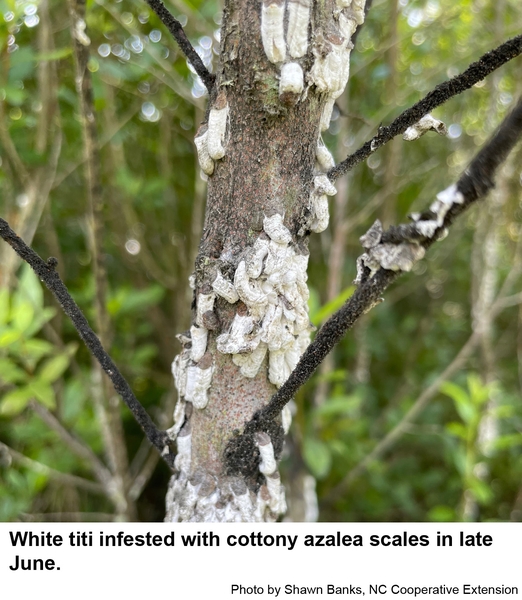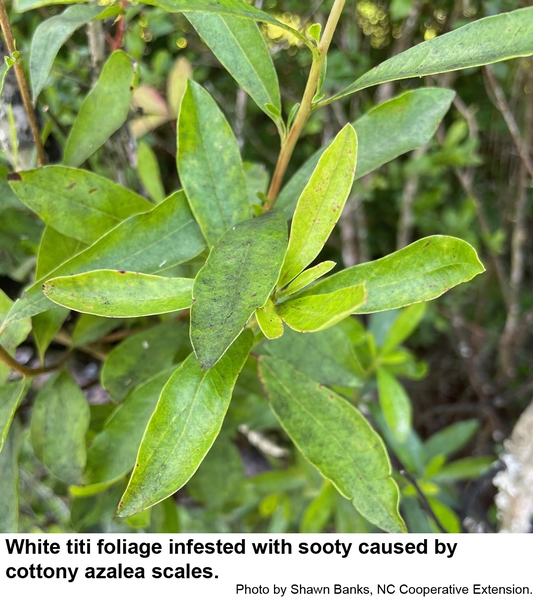Description and Biology
Cottony azalea scales, Pulvinaria ericicola, are sometimes called cottony taxus scales (Although that seems like a stretch to me as cottony camellia scales are also called cottony taxus scales.). Mature females are round to elongate oval in top view (no description of males available) and up to a little over 1/8 inch long. They are dark red to yellow and usually covered with small plates of glassy wax. This scale is often collected from roots of their host plants as well as stems. Young, fertilized females overwinter and resume development in spring. Mature females secrete their cottony ovisacs in which they lay their eggs, usually in late April or early May. Hundreds of pale orange eggs are laid beneath and behind the female's body. Ovisacs are two or more times longer than the scales and are relatively flat, white, and fluffy. Eggs hatch in late May through early June. Tiny parasitic wasps usually exact a heavy toll on nymphs that settle above the soil line. Nymphs develop throughout the growing season by inserting their slender mouthparts through the bark until they reach phloem tissue that is rich in sugars compared to other nutrients. These scales pass along excess sugar as trisaccharides in a sticky solution called honeydew. Sooty molds often colonize honeydew, further disfiguring heavily infested plants.
Host Plants
Cottony azalea scales have been reported from blueberry, Lyonia ferruginea (staggerbush, tree lyonia, dragon tree), huckleberry, and rhododendron (including azaleas). All of these plants are in the plant family Ericaceae whereas Taxus is in the coniferous family Taxaceae, which indicates that "cottony taxus scale" is not an appropriate common name for this scale. However, it was recently collected from white titi, Cyrilla racemiflora, family Cyrillaceae, in North Carolina—probably a new host record for us.
Residential Recommendations
Cottony azalea scale eggs hatch in late May through early June, a time when crawlers on stems are completely susceptible to insecticide sprays. Amost any insecticide labeled for residential landscape use will give satisfactory control of the crawlers as long as the pesticide is applied directly to the crawlers. Consider using a horticultural oil or summer oil as a spray because these oils are relatively safe for humans and pets, and they are toxic to armored scales, soft scales, aphids, and mites. Oils leave little toxic residue behind to threaten beneficial insects and mites that prey upon various kinds of scale insects. Early in the growing season, wait until the new growth has emerged and hardened off a little. The first week in June is a very good time to treat. Use 5 tablespoons of oil in a gallon of water, shake it up, and spray thoroughly. Spray the infested plants again two weeks later in case additional crawlers have hatched. If the weather is dry and hot, spray either in the cool of the morning or cool of the evening. It is a good idea to water the plants before hand, too. If the scale population persists the following year, it may be from crawlers that were feeding on the roots where they were better protected from parasites and pesticide sprays. Treating infested shrubs and the soil around them with a systemic insecticide such as imidacloprid should give more than adequate control (If only a few plants are treated, the effect of imidacloprid on pollinators is probably negligible). It can be frustrating to figure out just what is the active ingredient of a pesticide formulation. By law, the active ingredient of all pesticides have to be listed on the front label although that information is usually in very small font near the bottom.
Other Resources
- Horticultural Oils for Ornamental Plants. Frank, S. et al. 2023 (revised). Entomology Insect Notes, NC State Extension Publications.
- Morphology and Systematics of Coccidae of Virginia with Notes on Their Biology (Homoptera: Coccoidea). Res. Div. Bull. 74. Williams, M. L. and M. Kosztarab. Virginia Polytechnic Institute and State University. 215 pp.
- Soft Scale Identification and Management on Ornamental Plants. Frank, S. 2010. Entomology Insect Notes, NC State Extension Publications.
- The Soft Scale Insects of Florida, Homoptera: Coccoidea: Coccidae). Hamon, A. B. and M. L. Williams. 1984. Florida Dept. Agr. & Consumer Serv., Div. Plant Industry. Contribution 600.
- NC State Extension Plant Pathology Publications and Factsheets
- NC State Horticultural Science Publications
- Plant Disease Notes
- North Carolina Agricultural Chemicals Manual
For assistance with a specific problem, contact your local N.C. Cooperative Extension center.
This factsheet has not been peer reviewed.
Publication date: June 30, 2023
Recommendations for the use of agricultural chemicals are included in this publication as a convenience to the reader. The use of brand names and any mention or listing of commercial products or services in this publication does not imply endorsement by NC State University or N.C. A&T State University nor discrimination against similar products or services not mentioned. Individuals who use agricultural chemicals are responsible for ensuring that the intended use complies with current regulations and conforms to the product label. Be sure to obtain current information about usage regulations and examine a current product label before applying any chemical. For assistance, contact your local N.C. Cooperative Extension county center.
N.C. Cooperative Extension prohibits discrimination and harassment regardless of age, color, disability, family and marital status, gender identity, national origin, political beliefs, race, religion, sex (including pregnancy), sexual orientation and veteran status.


